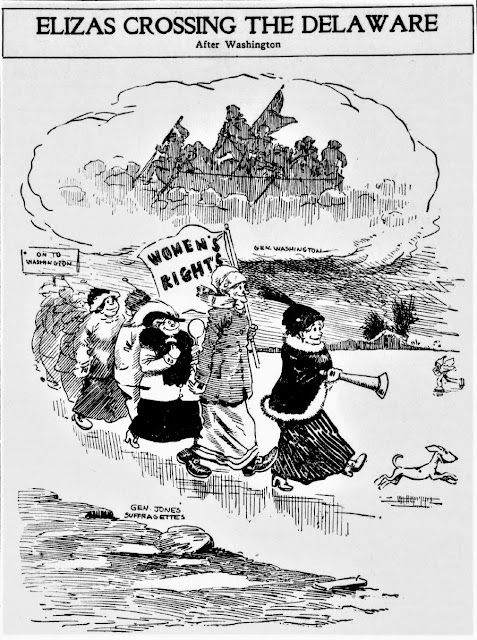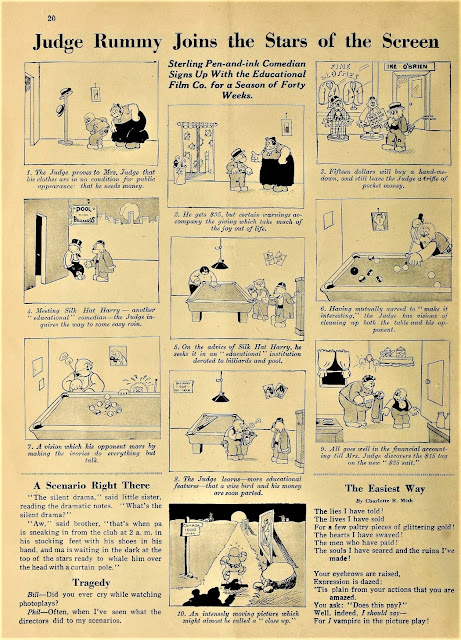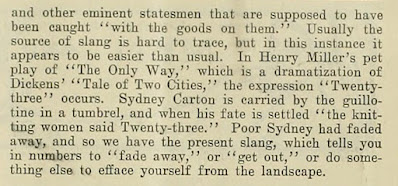‘Merriest Guy in America’
New York – “Tad,” the cartoonist who has been called “The Merriest Guy In America,” died In his sleep yesterday at his home in Great Neck, L. I. After nine years of taking it from fate as an invalid and a last five years of bondage to a wheel chair.
He was 52 years old last Monday and his real name was Thomas Aloysius Dorgan. He was born In San Francisco, and the first national intimation that something had happened to make life a little easier to bear came a few years later when the phrase, “Twenty-three- Skidoo” swept the country. That was “Tad’s” phrase, and it skidooed him from a $5-a-week office boy on a San Francisco newspaper to the East, three square meals every day, and the gorgeous idea of making “Judge Rummy” a national institution during the Thaw trial.
The expressions “Tad” kept putting in the mouths of his horde of cartoon characters have since been tossed glibly about by millions of his fellow citizens. Most of them - the phrases - are meaningless but irresistible.
[3] TAD DORGAN, ‘Elizas Crossing the Delaware – After Washington,’ LA Herald, Feb 24, 1913
“We Have No Bananas”
“Officer, call a cop,” “Daddy, I see ducks,” “See what the boys in the back room will have” - these awaken memories as sentimental as love songs. “Dumb-bell” is prying its way into dictionaries, as may “Cake-eater,” “Dumb Dora,” “Drugstore cowboy” and “Nickel-nurser.”
They are all “Tad’s”, and so are “Finale hoppers,” “Storm and Strife,” “Cat's Meow,” “For crying out loud,” and “What, no spinach?”
“Yes, we have no bananas” was his, too, and it became the most popular song of a decade. Many like best of all, however, his classic: “Drop that wheelbarrow - what do you know about machinery?” Although, “Let him up —he’s all out” has its loyal following.
These gaudy expressions rolled off “Tad’s” pen and a week later they would be in the mouth of every amateur wise-cracker from Baton Rouge to Point Barrow. “Tad's” eye first discerned that a hat was a “skimmer” and that eyeglasses were “cheaters.”
Dorgan was possessed of an encyclopedic savvy of prize fighting as well as of the homelier amusements of his fellow citizens. His stories of the Gans - Nelson and Jeffries - Johnson fights are classics of sports writing. He looked at fights and fighters with the same tender attention that Sir Joseph Duveen bestows upon old masters, and his tendency was to become tremendously excited.
[4] TAD DORGAN & HYPE IGOE, c. 1910. Courtesy Rob Stolzer (see more HERE)
Heart Trouble
The Dempsey-Miske affair in Benton Harbor, Mich., in 1920 seemed mild enough to many people but it marked the beginning of the end for “Tad.” He was forbidden by physicians ever to attend another boxing match. Something had happened to his heart.
Even at that time, “Tad’s” general appearance was that of an object any reasonably determined wind could blow through a keyhole. He was more than thin. Such hair as he had was of an indeterminate sandy shade, He limped slightly with a motion that furthered the effect of scuttling before the wind.
And the second, third and fourth fingers of his right hand had been lost somewhere early in his career. A factory accident in his youth was reported to be responsible for the missing digits. This was before “Tad” learned to draw, grasping his pen with the thumb and forefinger remaining to him.
“Tad” was as little handicapped in work by his heart as by his crippled hand. Confined to a wheel chair for the past five years, he continued to write boxing articles and draw his cartoons, getting his sports news over the radio. He died three weeks ahead in his work. His last cartoon, for publication May 21, was delivered to the office of King Feature Syndicate two days ago.
by an unknown author from an unknown newspaper from 1929
Note: TAD Dorgan must have been familiar with Cockney slang where “trouble and strife” referred to “wife.” TAD apparently used (above) the phrase “storm and strife” to the same purpose.
One old baseball term that qualified as good Americanese is “boner.” This is an abbreviation of “bonehead play.” The first man to use this form was T. A. Dorgan, or Tad, the sport-page cartoonist of the Hearst papers who had a baseball character called Bonehead Barry, the bush league bear. We owe “bonehead” and “boner” to him. – Westbrook Pegler, May 27, 1947
According to an article in ‘Fights and Fighters from Punch’s Scrapbook,’ The Mail (Adelaide SA), Oct 29, 1938: In writing an article about the match lost by Terrible Terry McGovern to Young Corbett on Nov 28, 1901, Tad Dorgan said, “Corbett got Terry’s Goat” — and thereby coined a phrase.”
Note: About 23 Skidoo, the phrase credited to TAD Dorgan and popular in the 1890s. 23 was revived by FB Opper according to The Wasp Jan 27, 1906. Both were based on the knitting lady at the foot of the guillotine in Dickens. Skidoo was from the Greek word shedad, the Norse skedad, the American skedaddle meaning scatter or scat.



















